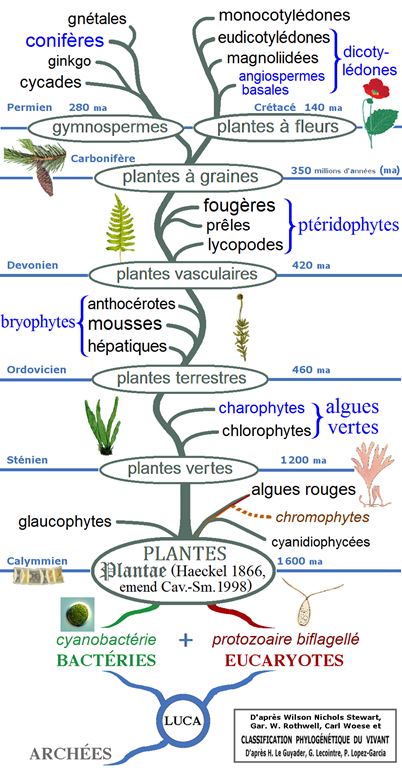Gingembre
(Zingiber officinale)

-9/-10°C
Une plante herbacée vivace aux tiges souterraines gonflées. Il peut atteindre 30 à 100 cm de hauteur. La tige souterraine ou le rhizome se ramifie et est horizontal près d ... (traduction automatique)
→suite
Gingembre 

Une plante herbacée vivace aux tiges souterraines gonflées. Il peut atteindre 30 à 100 cm de hauteur. La tige souterraine ou le rhizome se ramifie et est horizontal près de la surface du sol. Il mesure environ 1,5 à 2,5 cm d'épaisseur. L'intérieur du rhizome est jaune et il est recouvert d'écailles formant un c... (traduction automatique) →suite
Classification
- Classique : en haut de l\'écran, sous le coeur.
- Phylogénétique :
- Clade 4 : Angiospermes ;
- Clade 3 : Monocotylédones ;
- Clade 2 : Commelinidées ;
- Ordre APN : Zingiberales ;
- Famille APN : Zingiberaceae ;
Illustration : cet arbre phylogénétique des plantes montre les principaux clades et groupes traditionnels (monophylétiques en noir et paraphylétiques en bleu).
Dénominations
✖- Nom botanique : Zingiber officinale Roscoe (1807)
- Synonymes français : gingembre officinale
- Synonymes : Amomum angustifolium Salisb, Amomum zingiber L, Zingiber aromaticum Noronha, Zingiber cholmondeleyi (F. M. Bailey) K. Schum, Zingiber missionis Wall, Zingiber sichuanense Z.Y. Zhu et al, Zingiber zingiber (L.) H. Karst
- Noms anglais et locaux : ginger, jiang (cn transcrit), Ingwer (de), zenzero (it), shoga (jp romaji), saenggang (ko transcrit), gengibre (pt), jengibre (es), ingefära (sv)
Description et culture
✖- dont infos de "FOOD PLANTS INTERNATIONAL" :
Description :
Une plante herbacée vivace aux tiges souterraines gonflées. Il peut atteindre 30 à 100 cm de hauteur. La tige souterraine ou le rhizome se ramifie et est horizontal près de la surface du sol. Il mesure environ 1,5 à 2,5 cm d'épaisseur. L'intérieur du rhizome est jaune et il est recouvert d'écailles formant un cercle autour de lui. Les feuilles sont longues (30 cm) et étroites (4 cm). Chaque pousse feuillue a généralement 8 à 12 feuilles en deux lignes verticales sur leurs côtés opposés. Le limbe se rétrécit uniformément jusqu'à l'extrémité de la feuille. La fleur est un cône de 6 cm de long sur une tige atteignant 30 cm de long. (Les fleurs ne sont pas produites dans tous les endroits.{{{0(+x) (traduction automatique).
Original : A perennial herb with swollen underground stems. It can grow 30-100 cm tall. The underground stem or rhizome branches and is horizontal near the soil surface. It is about 1.5-2.5 cm thick. Inside the rhizome is yellow and it is covered with scales forming a circle around it. The leaves are long (30 cm) and narrow (4 cm). Each leafy shoot usually has 8-12 leaves in two vertical lines on opposite sides of them. The leaf blade narrows evenly to the leaf tip. The flower is a cone 6 cm long on a stalk up to 30 cm long. (Flowers are not produced in all locations.){{{0(+x).
Production :
Il faut 12 mois pour mûrir. Il est récolté plusieurs fois. Les jeunes pousses sont coupées à environ 7,5 cm de hauteur{{{0(+x) (traduction automatique).
Original : It takes 12 months to mature. It is harvested several times. The young shoots are cut when about 7.5 cm high{{{0(+x).
Culture :
Une partie du rhizome est plantée à 5 à 7 cm sous la surface du sol. Parfois, une ombre légère est utilisée, mais elle peut être cultivée sans ombre{{{0(+x) (traduction automatique).
Original : A portion of the rhizome is planted 5-7 cm below the surface of the soil. Sometimes light shade is used but it can be grown without shade{{{0(+x).
 Consommation (rapports de comestibilité, parties utilisables et usages alimentaires correspondants)
Consommation (rapports de comestibilité, parties utilisables et usages alimentaires correspondants)
✖
Partie(s) comestible(s){{{0(+x) : rhizome, racine, feuilles, herbe, épice, légume{{{0(+x).
Utilisation(s)/usage(s){{{0(+x) culinaire(s) :
-le rhizome souterrain est consommé cru ou en salade ;
-les jeunes pousses sont épicées et peuvent être consommées ; ces jeunes pousses sont consommées comme légume ; elles sont également picklées ;
-le rhizome peut être séché et réduit en poudre ; ces vieilles racines sont utilisées comme épice ; elles sont conservées dans du sirop ;
-l'huile de gingembre est utilisée comme aromatisant ;
-le gingembre est utilisé pour les boissons{{{0(+x) ;
-le jus peut être utilisé pour faire cailler le lait (agent de coagulation/caillage /caille-lait substitut de présure) pour la préparation de fromage{{{~~244µ(dp*).
Partie testée :
racine moulue séchée{{{0(+x) (traduction automatique). Original : Root- dried ground{{{0(+x)| Taux d'humidité | Énergie (kj) | Énergie (kcal) | Protéines (g) |
|---|---|---|---|
| 9.4 | 1452 | 347 | 9.1 |
| Pro- vitamines A (µg) |
Vitamines C (mg) | Fer (mg) | Zinc (mg) |
| 15 | 7.0 | 11.5 | 4.7 |
 Risques et précautions à prendre
Risques et précautions à prendre
✖
néant, inconnus ou indéterminés.
Galerie(s)
✖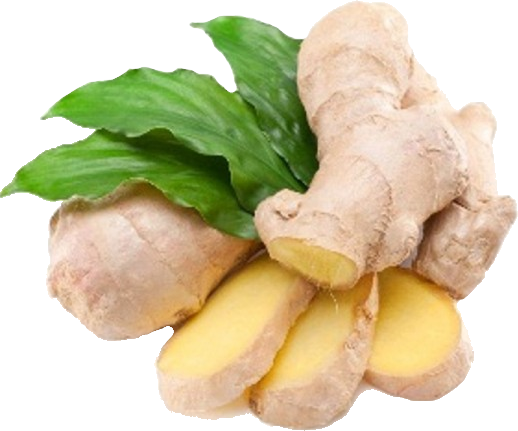
Par Maria Brooklyn, via x
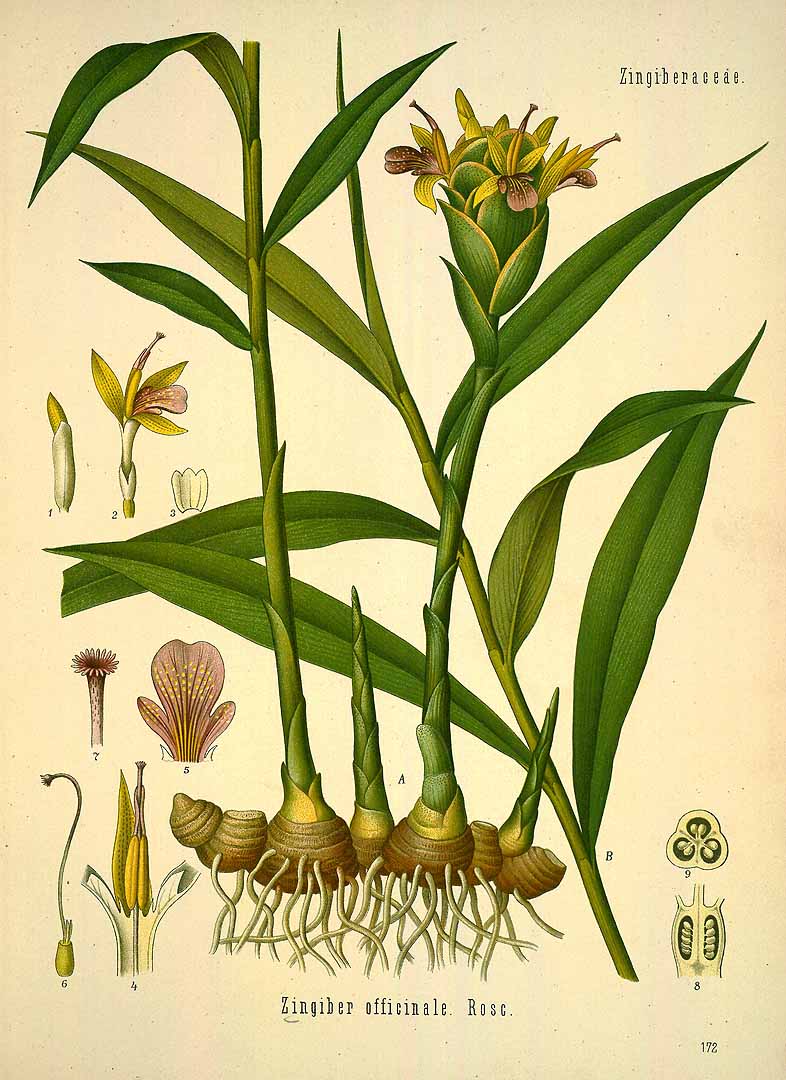
Par Köhler, F.E., Köhler?s Medizinal Pflanzen (1883-1914) Med.-Pfl., via plantillustrations
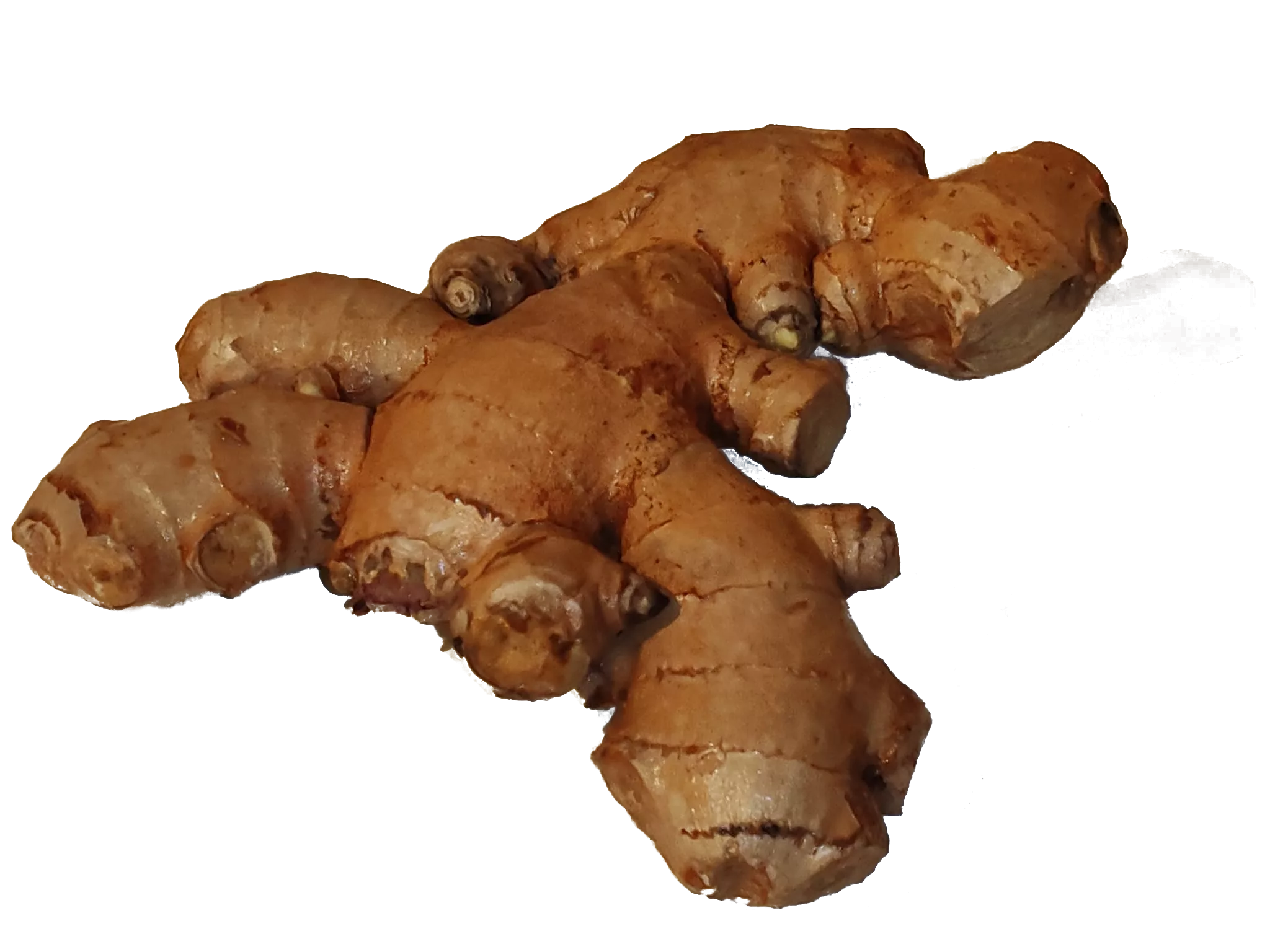
Par Patrick Le Ménahèze (travail personnel légué au domaine public), via x
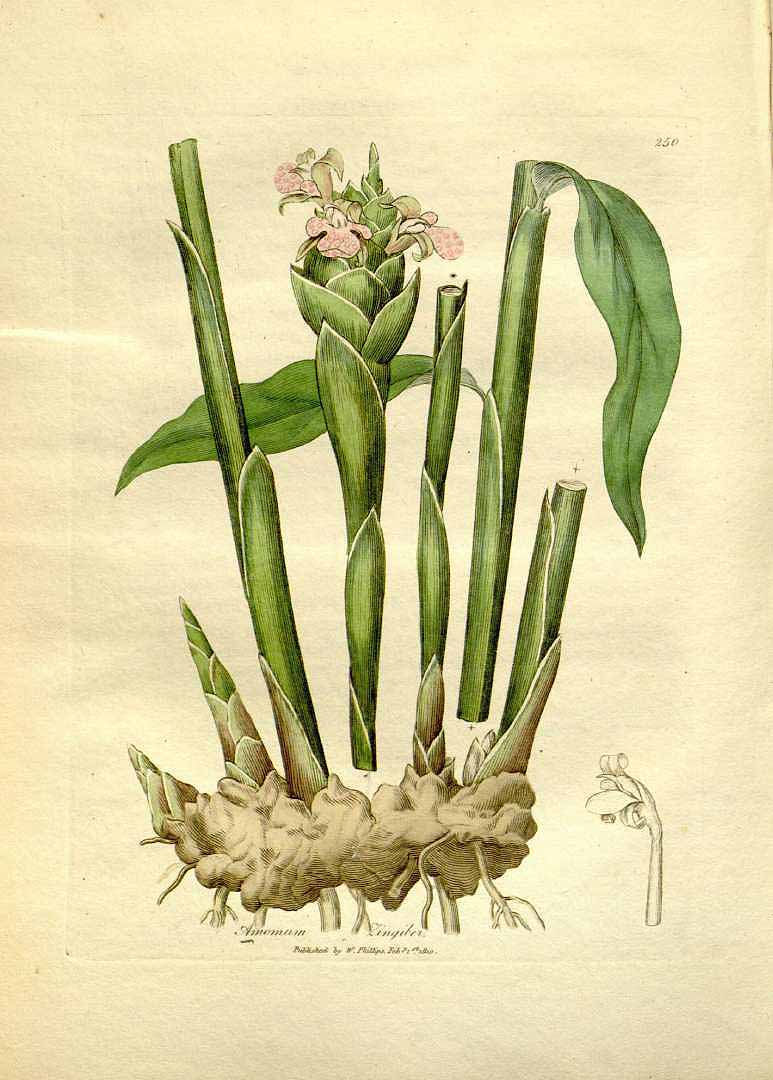
Par Woodville, W., Hooker, W.J., Spratt, G., Medical Botany, 3th edition (1832) Med. Bot., ed. 3, via plantillustrations
Autres infos
✖dont infos de "FOOD PLANTS INTERNATIONAL" :
Statut :
C'est un légume cultivé commercialement. Commun dans la plupart des régions de Papouasie-Nouvelle-Guinée et consommé en quantité comme légume et comme épice{{{0(+x) (traduction automatique).
Original : It is a commercially cultivated vegetable. Common in most areas of Papua New Guinea and eaten in quantity as a vegetable and as a spice{{{0(+x).
Distribution :
C'est une plante tropicale. Il est principalement cultivé du niveau de la mer jusqu'à 1900 m d'altitude sous les tropiques, mais poussera dans des endroits plus élevés. Il a besoin d'un sol fertile et meuble. Il fait mieux avec beaucoup d'humus. Il nécessite une pluviométrie de 1500 mm ou plus par an. Il fait mieux là où il y a une courte saison sèche et une bonne température chaude. Il ne supporte pas l'engorgement. Au Népal, il atteint environ 2500 m d'altitude. Il convient aux zones de rusticité 9-12. Au Sichuan et au Yunnan{{{0(+x) (traduction automatique).
Original : It is a tropical plant. It is mainly grown from sea level up to 1900 m altitude in the tropics but will grow at higher places. It needs a loose fertile soil. It does best with plenty of humus. It requires a rainfall of 1500 mm or more per year. It does best where there is a short dry season and a good hot temperature. It cannot stand water-logging. In Nepal it grows to about 2500 m altitude. It suits hardiness zones 9-12. In Sichuan and Yunnan{{{0(+x).
Localisation :
Afrique, Andaman Is., Angola, Antigua-et-Barbuda, Asie, Australie, Bangladesh, Bhoutan, Bolivie, Brésil, Burkina Faso, Cambodge, Afrique centrale, Amérique centrale, Chine, République démocratique du Congo, Îles Cook, Costa Rica, Cuba, Afrique de l'Est , Timor oriental, Équateur, Éthiopie, Fidji, FSM, Grenade, Guam, Guinée, Guinée, Guinée-Bissau, Guyane, Hawaï, Haïti, Himalaya, Honduras, Inde, Indochine, Indonésie, Jamaïque, Japon, Kenya, Kiribati, Laos, Madagascar, Malaisie, Malawi, Marquises, Maurice, Mozambique, Myanmar, Nauru, Népal, Nicaragua, Nigéria, Nord-est de l'Inde, Pacifique, Papouasie-Nouvelle-Guinée, PNG, Pérou, Philippines, Pohnpei, Réunion, Samoa, Sao Tomé-et-Principe, Asie du Sud-Est, Sénégal, Sikkim, Îles Salomon, Amérique du Sud, Sri Lanka, Sainte-Lucie, Taïwan, Thaïlande, Timor-Leste, Tuvalu, Ouganda, USA, Vanuatu, Vietnam, Afrique de l'Ouest, Zimbabwe{{{0(+x) (traduction automatique).
Original : Africa, Andaman Is., Angola, Antigua and Barbuda, Asia, Australia, Bangladesh, Bhutan, Bolivia, Brazil, Burkina Faso, Cambodia, Central Africa, Central America, China, Congo DR, Cook Islands, Costa Rica, Cuba, East Africa, East Timor, Ecuador, Ethiopia, Fiji, FSM, Grenada, Guam, Guinea, Guinée, Guinea-Bissau, Guyana, Hawaii, Haiti, Himalayas, Honduras, India, Indochina, Indonesia, Jamaica, Japan, Kenya, Kiribati, Laos, Madagascar, Malaysia, Malawi, Marquesas, Mauritius, Mozambique, Myanmar, Nauru, Nepal, Nicaragua, Nigeria, Northeastern India, Pacific, Papua New Guinea, PNG, Peru, Philippines, Pohnpei, Reunion, Samoa, Sao Tome and Principe, SE Asia, Senegal, Sikkim, Solomon Islands, South America, Sri Lanka, St Lucia, Taiwan, Thailand, Timor-Leste, Tuvalu, Uganda, USA, Vanuatu, Vietnam, West Africa, Zimbabwe{{{0(+x).
Notes :
Il existe environ 100 à 150 espèces de Zingiber{{{0(+x) (traduction automatique).
Original : There are about 100-150 Zingiber species{{{0(+x).
Rusticité (résistance face au froid/gel, climat)
✖-9/-10°C
Liens, sources et/ou références
✖Sources et/ou références :
"Ginger milk curd" WIKIPEDIA, en anglais) ; 5"Plants For A Future" (en anglais) ;
dont classification : "The Plant List" (en anglais) ;
dont livres et bases de données : 0"Food Plants International" (en anglais), 244Dictionaire oeconomique (livre, par Noel Chomel, Richard Bradley) ;
Le Truffaut du Potager (collectif, éditions Larousse, 2010) / détails du livre ; PM
dont biographie/références de "FOOD PLANTS INTERNATIONAL" :
Ali, A. M. S., 2005, Homegardens in Smallholder Farming Systems: Examples from Bangladesh. Human Ecology, Vol. 33, No. 2 pp. 245-270 ; Ambasta, S.P. (Ed.), 2000, The Useful Plants of India. CSIR India. p 701 ; Anderson, E. F., 1993, Plants and people of the Golden Triangle. Dioscorides Press. p 224 ; Bennett, B. C., 1990, Useful Plants of Amazonian Ecuador. US Agency for International Development. Fifth Progress Report. New York Botanical Gardens. p 40 ; Bianchini, F., Corbetta, F., and Pistoia, M., 1975, Fruits of the Earth. Cassell. p 212 ; Bodkin, F., 1991, Encyclopedia Botanica. Cornstalk publishing, p 1036 ; Bodner, C. C. and Gereau, R. E., 1988, A Contribution to Bontoc Ethnobotany. Economic Botany, 43(2): 307-369 ; Borrell, O.W., 1989, An Annotated Checklist of the Flora of Kairiru Island, New Guinea. Marcellin College, Victoria Australia. p 43 ; Bremness, L., 1994, Herbs. Collins Eyewitness Handbooks. Harper Collins. p 227 ; Burkill, H. M., 1985, The useful plants of west tropical Africa, Vol. 5. Kew. ; Burkill, I.H., 1966, A Dictionary of the Economic Products of the Malay Peninsula. Ministry of Agriculture and Cooperatives, Kuala Lumpur, Malaysia. Vol 2 (I-Z) p 2338 ; Burnie, G & Fenton-Smith, J., 1999, A Grower's Guide to Herbs. Murdoch Books. p 37 ; Cheifetz, A., (ed), 1999, 500 popular vegetables, herbs, fruits and nuts for Australian Gardeners. Random House p 163 ; Chin, H. F., 1999, Malaysian Vegetables in Colour. Tropical Press. p 82 ; Cobley, L.S. (rev. Steele, W.M.) 2nd Ed., 1976, An Introduction to the Botany of Tropical Crops. Longmans. p 230 ; Coe, F. G. and Anderson, G. J., 1999, Ethnobotany of the Sumu (Ulwa) of Southeastern Nicaragua and Comparisons with Miskitu Plant Lore. Economic Botany Vol. 53. No. 4. pp. 363-386 ; Cundall, P., (ed.), 2004, Gardening Australia: flora: the gardener's bible. ABC Books. p 1496 ; Dahlen, M., 1995, A Cook's Guide to Chinese Vegetables. Odyssey Guides. p 17, 112 ; Esperanca, M. J., 1988. Surviving in the wild. A glance at the wild plants and their uses. Vol. 1. p 382 ; Facciola, S., 1998, Cornucopia 2: a Source Book of Edible Plants. Kampong Publications, p 248 ; Foo, J.T.S.(ed), 1996, A Guide to Common Vegetables. Singapore Science Foundation. p 154 ; French, B.R., 1986, Food Plants of Papua New Guinea, A Compendium. Asia Pacific Science Foundation p 99 ; French, B.R., 2010, Food Plants of Solomon Islands. A Compendium. Food Plants International Inc. p 160 ; Goode, P., 1989, Edible Plants of Uganda. FAO p 26, 30 ; Hani Medicine of Xishuangbanna, 1999, p 183 ; Hedrick, U.P., 1919, (Ed.), Sturtevant's edible plants of the world. p 704 ; Hemphill, I, 2002, Spice Notes Macmillan. p 195 ; Heywood, V.H., Brummitt, R.K., Culham, A., and Seberg, O., 2007, Flowering Plant Families of the World. Royal Botanical Gardens, Kew. p 408 ; Hibbert, M., 2002, The Aussie Plant Finder 2002, Florilegium. p 311 ; Hutton, W., 1997, Tropical Herbs and Spices of Indonesia. Periplus. p 36 ; Hu, Shiu-ying, 2005, Food Plants of China. The Chinese University Press. p 329 ; Jacquat, C., 1990, Plants from the Markets of Thailand. D.K. Book House p 118 ; Japanese International Research Centre for Agricultural Science www.jircas.affrc.go.jp/project/value_addition/Vegetables ; Kapelle, M., et al, 2000, Useful plants within a Campesino Community in a Costa Rican Montane Cloud Forest. Mountain Research and Development, 20(2): 162-171 ; Kays, S. J., and Dias, J. C. S., 1995, Common Names of Commercially Cultivated Vegetables of the World in 15 languages. Economic Botany, Vol. 49, No. 2, pp. 115-152 ; Kiple, K.F. & Ornelas, K.C., (eds), 2000, The Cambridge World History of Food. CUP p 433, 1778 ; Kybal, J., 1980, Herbs and Spices, A Hamlyn Colour Guide, Hamlyn Sydney p 206 ; Larkcom, J., 1991, Oriental Vegetables, John Murray, London, p 127 ; Larsen, K., Ibrahim, H., Khaw, S.H., & Saw, L.G., 1999, Gingers of Peninsula Malaysia and Singapore. Natural History Publications (Borneo). p 7 ; Lazarides, M. & Hince, B., 1993, Handbook of Economic Plants of Australia, CSIRO. p 251 ; Lembaga Biologi Nasional, 1977, Ubi-Ubian, Balai Pustaka, Jakarta. p 40 ; Macmillan, H.F. (Revised Barlow, H.S., et al), 1991, Tropical Planting and Gardening. Sixth edition. Malayan Nature Society. Kuala Lumpur. p 380 ; Manandhar, N.P., 2002, Plants and People of Nepal. Timber Press. Portland, Oregon. p 486 ; Martin, F.W. & Ruberte, R.M., 1979, Edible Leaves of the Tropics. Antillian College Press, Mayaguez, Puerto Rico. p 43, 225 ; Mertz, O., Lykke, A. M., and Reenberg, A., 2001, Importance and Seasonality of Vegetable Consumption and Marketing in Burkina Faso. Economic Botany, 55(2):276-289 ; Molla, A., Ethiopian Plant Names. https://www.ethiopic.com/aplants.htm ; Mulherin, J., 1994, Spices and natural flavourings. Tiger Books, London. p 52 ; Norrington, L., & Campbell, C., 2001, Tropical Food Gardens. Bloomings Books. p 64 ; Omawale, 1973, Guyana's edible plants. Guyana University, Georgetown p 67 ; Owen, S., 1993, Indonesian Food and Cookery, INDIRA reprints. p 57 ; Peekel, P.G., 1984, (Translation E.E.Henty), Flora of the Bismarck Archipelago for Naturalists, Division of Botany, Lae, PNG. p 100, 99 ; Phon, P., 2000, Plants used in Cambodia. © Pauline Dy Phon, Phnom Penh, Cambodia. p 644 ; Purseglove, J.W., 1972, Tropical Crops. Monocotyledons. Longmans p 533 ; Rashid, H. E., 1977, Geography of Bangladesh. Westview. p 278 ; Smith, A.C., 1979, Flora Vitiensis Nova, Lawaii, Kuai, Hawaii, Volume 1 p 194 ; Smith, P.M., 1979, Ginger, in Simmonds, N.W., (ed), Crop Plant Evolution. Longmans. London. p 324 ; Solomon, C., 2001, Encyclopedia of Asian Food. New Holland. p 169 ; Staples, G.W. and Herbst, D.R., 2005, A tropical Garden Flora. Bishop Museum Press, Honolulu, Hawaii. p 768 (Drawing) ; Terra, G.J.A., 1973, Tropical Vegetables. Communication 54e Royal Tropical Institute, Amsterdam, p 83 ; Trans. Linn. Soc. London 8:348. 1807 ; Tredgold, M.H., 1986, Food Plants of Zimbabwe. Mambo Press. p 61 ; van Wyk, B., 2005, Food Plants of the World. An illustrated guide. Timber press. p 389 ; Vickery, M.L. and Vickery, B., 1979, Plant Products of Tropical Africa, Macmillan. p 87 ; Walter, A. & Lebot, V., 2007, Gardens of Oceania. ACIAR Monograph No. 122. p 296 ; Williams, C.N., Chew, W.Y., and Rajaratnam, J.A., 1989, Tree and Field Crops of the Wetter Regions of the Tropics. Longman, p 227 ; Woodward, P., 2000, Asian Herbs and Vegetables. Hyland House. p 135 ; Wu Delin, Larsen, K., Zingiberaceae. Flora of China. ; Zuchowski W., 2007, Tropical Plants of Costa Rica. A Zona Tropical Publication, Comstock Publishing. p 208
Recherche de/pour :
- "Zingiber officinale" sur Google (pages et
images) ;
INPI (en anglais) ;
TROPICOS (en anglais) ;
Tela Botanica ;
Pl@ntNet ;
Pl@ntUse ;
- "Gingembre" sur Google (pages, images et recettes) ;
- "Zingiber officinale" sur Google (pages et
images) ;
INPI (en anglais) ;
TROPICOS (en anglais) ;
Tela Botanica ;
Pl@ntNet ;
Pl@ntUse ;
Espèces du même genre (Zingiber)
✖28 taxons
- Zingiber bradleyanum
- Zingiber cernuum
- Zingiber chrysostachys
- Zingiber corallinum
- Zingiber densissimum
- Zingiber fragile
- Zingiber gramineum
- Zingiber griffithii
- Zingiber kawagoii
- Zingiber kelabitianum
- Zingiber longipedunculatum
- Zingiber mioga (Thunb.) Roscoe (Mioga)
- Zingiber montanum (J. Koenig) Link ex A. Dietr. (Bangle)
- Zingiber neotruncatum
- Zingiber odoriferum
- Zingiber officinale Roscoe (Gingembre)
- Zingiber oligophyllum
- Zingiber orbiculatum
- Zingiber ottensii
- Zingiber roseum
- Zingiber rubens Roxb. (Gingembre du bengale)
- Zingiber smilesianum
- Zingiber spectabile
- Zingiber squarrosum
- Zingiber striolatum
- Zingiber tuanjuum
- Zingiber wightianum
- Zingiber zerumbet (L.) Roscoe ex Sm. (Gingembre sauvage)
Espèces de la même famille (Zingiberaceae)
✖50 taxons (sur 255)
- Achasma loroglossum
- Aframomum albiflorum
- Aframomum alboviolaceum (Ridl.) K.Schum. (Aframome blanc violacée (tp*))
- Aframomum angustifolium (Sonn.) K. Schum. (Longoza)
- Aframomum cereum
- Aframomum citratum (C.Pereira) K.Schum. (Mbongo)
- Aframomum corrorima (C. Pereira) P. C. M. Jansen (Korarima)
- Aframomum daniellii (Hook.f.) K.Schum. (Cardamome du cameroun)
- Aframomum elliotii
- Aframomum exscapum (Sims) Hepper (Maniguette)
- Aframomum giganteum
- Aframomum laurentii
- Aframomum letestuanum
- Aframomum longiscapum
- Aframomum luteoalbum
- Aframomum mala
- Aframomum melegueta (Rosc.) K. Schum. (Maniguette)
- Aframomum polyanthum
- Aframomum pruinosum
- Aframomum rostratum
- Aframomum strobilaceum (Sm.) Hepper (Maniguette)
- Aframomum subsericeum
- Aframomum sulcatum
- Aframomum thonneri
- Aframomum verrucosum
- Aframomum zambesiacum (Baker) K.Schum. (Korarima des singes)
- Alpinia aquatica
- Alpinia arundelliana
- Alpinia athroantha
- Alpinia beamanii
- Alpinia blepharocalyx
- Alpinia caerulea (R.Br.) Benth. (Gingembre d'ornement)
- Alpinia calcarata
- Alpinia capitellata
- Alpinia chinensis
- Alpinia conchigera
- Alpinia coriandriodora
- Alpinia elegans
- Alpinia emaculata
- Alpinia galanga (L.) Willd. (Galanga)
- Alpinia glabra
- Alpinia globosa
- Alpinia hainanensis
- Alpinia japonica
- Alpinia javanica
- Alpinia kawakamii
- Alpinia kusshakuensis
- Alpinia kwangsiensis
- Alpinia latilabris
- Alpinia ligulata
- ...


